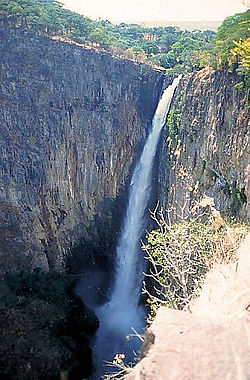Kalambo River
Appearance
| Kalambo River | |
|---|---|
 Kalambo Falls | |
 | |
| Location | |
| Country | Rukwa Region, Tanzania |
| Country | Northern Province, Zambia |
| Physical characteristics | |
| Source | Ufipa Plateau |
| • location | Zambia |
| • elevation | 1,800 m (5,900 ft) |
| Mouth | Lake Tanganyika |
• location | Tanzania |
• elevation | 770 m (2,530 ft) |
| Length | 50 km (31 mi) |
The Kalambo River forms part of the border between Zambia and Tanzania. It is a comparatively small stream which rises on the Ufipa Plateau in Rukwa Region,Tanzania]] north-east of Mbala at an elevation of about 1,800 metres (5,900 ft) and descends into the Albertine Rift, entering the southeastern end of Lake Tanganyika at an elevation of about 770 metres (2,530 ft), in a straight-line distance of only about 50 kilometres (31 mi).[citation needed] This accounts for its main claim to fame, its waterfall, Kalambo Falls, which is Africa's second highest falls (after South Africa's Tugela Falls). Below the falls, the river runs in a deep gorge.[citation needed]
The site of the river includes important archaeological sites.
References
[edit]- UNESCO, World Heritage Centre, Kalambo falls archaeological site (prehistoric settlement site), 11/06/1997.
- "Forestry." Encyclopædia Britannica. 2006. Encyclopædia Britannica Online. 17 June 2006 <http://search.eb.com/eb/article-26182>.
External links
[edit]- "Photo Gallery: Children enjoy a swim in Kalambo River at Kapozwa Village near Lake Tanganyika in Kalambo District, Rukwa Region". 2012. Archived from the original on 2012-09-04. Retrieved 2012-09-04.
